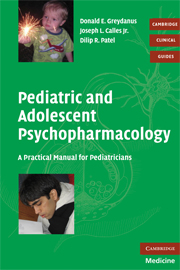Book contents
- Frontmatter
- Contents
- Contributors
- Foreword by Christopher K. Varley
- Foreword by Renée R. Jenkins
- Preface
- Acknowledgement
- 1 Principles of psychological management
- 2 The basics of pharmacology and neurotransmission
- 3 Basics of prescribing psychopharmacologic agents
- 4 Anxiety disorders
- 5 Attention deficit/hyperactivity disorder
- 6 Child and adolescent depression
- 7 Disruptive behavior and aggressive disorders
- 8 Schizophrenia in childhood and adolescence
- 9 Autism spectrum disorders
- 10 Psychotropic management of children and adolescents with cognitive–adaptive disabilities
- 11 Sleep disorders in children and adolescents
- 12 Tic disorders in children and adolescents
- 13 Substance abuse disorders
- Subject index
- References
13 - Substance abuse disorders
Published online by Cambridge University Press: 18 December 2009
- Frontmatter
- Contents
- Contributors
- Foreword by Christopher K. Varley
- Foreword by Renée R. Jenkins
- Preface
- Acknowledgement
- 1 Principles of psychological management
- 2 The basics of pharmacology and neurotransmission
- 3 Basics of prescribing psychopharmacologic agents
- 4 Anxiety disorders
- 5 Attention deficit/hyperactivity disorder
- 6 Child and adolescent depression
- 7 Disruptive behavior and aggressive disorders
- 8 Schizophrenia in childhood and adolescence
- 9 Autism spectrum disorders
- 10 Psychotropic management of children and adolescents with cognitive–adaptive disabilities
- 11 Sleep disorders in children and adolescents
- 12 Tic disorders in children and adolescents
- 13 Substance abuse disorders
- Subject index
- References
Summary
Introduction
Substance abuse is a major public health conundrum of adolescents and adults throughout the world. The major problem of addiction in the world has intensified since the unfortunate biochemical isolation of cocaine, heroin, and morphine in the nineteenth century. Criteria for substance abuse disorders are often based on definitions of the American Psychiatric Association's Diagnostic and Statistical Manual of Mental Disorders, Fourth Edition, Text Revision (DSM–IV–TR) that reflect a number of key symptoms. These definitions, however, are based on adult models, and not adolescents with various degrees of substance use and abuse patterns. DSM–IV–TR views substance abuse as a mental disorder that involves use of drugs or alcohol to the point that major life dysfunction occurs. Substance dependence involves at least three of seven DSM–IV–TR criteria as listed in Table 13.1.
Table 13.2 lists drugs of abuse and Table 13.3 reviews the use of selected illicit drugs by American adolescents from 2001 to 2005.
The epidemiology of adolescent substance abuse in selected European countries is summarized in Figure 13.1.
Prevalence rates for substance abuse or dependence range from 3–4% in middle adolescents to 10% in older youth (ages 17–19 years). Among patients admitted for substance abuse disorders, an increasing number report they started their drug use before age 13. Adolescents who have substance abuse disorders have increased risk for suicide, motor vehicle accidents, and hospitalizations due to drug overdose.
- Type
- Chapter
- Information
- Pediatric and Adolescent PsychopharmacologyA Practical Manual for Pediatricians, pp. 241 - 278Publisher: Cambridge University PressPrint publication year: 2008



